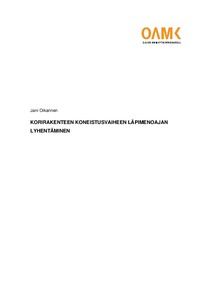Korirakenteen koneistusvaiheen läpimenoajan lyhentäminen
Oikarinen, Jani (2019)
Oikarinen, Jani
2019
Kaikki oikeudet pidätetään
Julkaisun pysyvä osoite on
https://urn.fi/URN:NBN:fi:amk-201903263799
https://urn.fi/URN:NBN:fi:amk-201903263799
Tiivistelmä
Opinnäytetyössä tarkasteltiin raitiovaunun korirakenteen koneistusvaihetta. Työn tavoitteena oli etsiä kehityskohteita, joilla voidaan lyhentää raitiovaunun korirakenteen koneistusvaiheen läpimenoaikaa. Korikohtaisena lyhennystavoitteena työlle oli asetettu 10–30 % aikaisemmin työhön käytetystä ajasta.
Tuotannon kehityksellä yritys pyrkii pääsemään sen tuotannolle asettamiin tavoitteisiin. Yksi tärkeimmistä tavoitteista on nopea tilaus-toimitusprosessi, jota pyritään kehittämään läpimenoaikaa lyhentämällä. Läpimenoajan lyhennyksellä voidaan tehostaa prosesseja, parantaa toiminnan laatua ja vähentää kustannuksia.
Opinnäytetyö aloitettiin koneistusprosessin nykytilanteen määrittämisellä. Prosessille määritettiin tämänhetkinen keskimääräinen läpimenoaika ja sen sisältämä arvoa tuottava aika. Lisäksi koneistusprosessille määritettiin kokonaistehokkuus, jolla tutkittiin käytettävyyttä, nopeutta ja laatua. Läpimenoaikaa lyhentäviä kehityskohteita etsittiin lean-ajattelun avulla. Keskeisimpänä lean-työkaluna työssä käytettiin SMED-menetelmää. SMED-menetelmän avulla prosessista etsittiin sisäisiä asetuksia, joita voidaan muuttaa ulkoisiksi. Työssä tutkittiin myös opinnäytetyön aikana jo meneillään olevien muutosten vaikutusta läpimenoaikaan.
Opinnäytetyön tuloksena saatiin useampi toisistaan riippumaton kehitysehdotus, joiden vaikutusta läpimenoaikaan arvioitiin. Työssä esitettyjen kehitysehdotusten arvioitiin lyhentävän koneistusvaiheen läpimenoaikaa 13,5 %. Lisäksi kehitysehdotukset nostaisivat työstökoneen käytettävyyttä 3,2 % ja prosessin kokonaistehokkuutta 2,9 %. Kehitysehdotuksien toteuttamisella yritys voi parantaa myös työturvallisuutta.
Kehitysehdotusten todellisia vaikutuksia ei opinnäytetyön aikana testattu, joten tulokset eivät ole luotettavia. Työssä esitetyt kehityskohteet ovat kuitenkin helposti toteutettavissa, eikä niistä aiheudu yritykselle huomattavia kustannuksia. The subject of the thesis was to find targets for development in the machining operation of body structure of a tram. The main purpose of the thesis was to cut down the delivery cycle of the machining operation. Targeted cut down of the delivery cycle was 10–30 % compared to the original delivery cycle.
Production development is a method used by the enterprise to strive for the objectives set to the production. One of the main objectives is a prompt order-delivery process. By cutting down the delivery cycle of order-delivery process, processed can be boosted, the quality of the operations can be enhanced, and costs can be cut down.
In the thesis the current average delivery cycle of machining operation was first determined. From the delivery cycle, the value producing time was identified and overall equipment effectiveness was calculated using availability, performance and quality. Lean thinking was used to find possible development targets for cutting down the delivery cycle. SMED-method was the main lean tool utilized. SMED was used to find and convert internal changeover steps to external steps. Also, the effect of some of the process changes, started before this thesis, were evaluated with the effects of identified development targets.
In the thesis multiple independent development targets were identified and their effects on the delivery cycle were evaluated. When utilizing the identified development targets, the estimated total cut down of the delivery cycle would be 13,5 %. Additionally, utilization of the development targets would enhance the performance of the machine tool by 3,2 % and the overall equipment effectiveness by 2,9 %. Also, the work safety would be enhanced when the development targets are utilized.
As the identified development targets were not utilized during the thesis, all the results are estimations and should not be treated as reliable results. All the development targets identified in the thesis are easily utilized and do not cause substantial costs to the enterprise.
Tuotannon kehityksellä yritys pyrkii pääsemään sen tuotannolle asettamiin tavoitteisiin. Yksi tärkeimmistä tavoitteista on nopea tilaus-toimitusprosessi, jota pyritään kehittämään läpimenoaikaa lyhentämällä. Läpimenoajan lyhennyksellä voidaan tehostaa prosesseja, parantaa toiminnan laatua ja vähentää kustannuksia.
Opinnäytetyö aloitettiin koneistusprosessin nykytilanteen määrittämisellä. Prosessille määritettiin tämänhetkinen keskimääräinen läpimenoaika ja sen sisältämä arvoa tuottava aika. Lisäksi koneistusprosessille määritettiin kokonaistehokkuus, jolla tutkittiin käytettävyyttä, nopeutta ja laatua. Läpimenoaikaa lyhentäviä kehityskohteita etsittiin lean-ajattelun avulla. Keskeisimpänä lean-työkaluna työssä käytettiin SMED-menetelmää. SMED-menetelmän avulla prosessista etsittiin sisäisiä asetuksia, joita voidaan muuttaa ulkoisiksi. Työssä tutkittiin myös opinnäytetyön aikana jo meneillään olevien muutosten vaikutusta läpimenoaikaan.
Opinnäytetyön tuloksena saatiin useampi toisistaan riippumaton kehitysehdotus, joiden vaikutusta läpimenoaikaan arvioitiin. Työssä esitettyjen kehitysehdotusten arvioitiin lyhentävän koneistusvaiheen läpimenoaikaa 13,5 %. Lisäksi kehitysehdotukset nostaisivat työstökoneen käytettävyyttä 3,2 % ja prosessin kokonaistehokkuutta 2,9 %. Kehitysehdotuksien toteuttamisella yritys voi parantaa myös työturvallisuutta.
Kehitysehdotusten todellisia vaikutuksia ei opinnäytetyön aikana testattu, joten tulokset eivät ole luotettavia. Työssä esitetyt kehityskohteet ovat kuitenkin helposti toteutettavissa, eikä niistä aiheudu yritykselle huomattavia kustannuksia.
Production development is a method used by the enterprise to strive for the objectives set to the production. One of the main objectives is a prompt order-delivery process. By cutting down the delivery cycle of order-delivery process, processed can be boosted, the quality of the operations can be enhanced, and costs can be cut down.
In the thesis the current average delivery cycle of machining operation was first determined. From the delivery cycle, the value producing time was identified and overall equipment effectiveness was calculated using availability, performance and quality. Lean thinking was used to find possible development targets for cutting down the delivery cycle. SMED-method was the main lean tool utilized. SMED was used to find and convert internal changeover steps to external steps. Also, the effect of some of the process changes, started before this thesis, were evaluated with the effects of identified development targets.
In the thesis multiple independent development targets were identified and their effects on the delivery cycle were evaluated. When utilizing the identified development targets, the estimated total cut down of the delivery cycle would be 13,5 %. Additionally, utilization of the development targets would enhance the performance of the machine tool by 3,2 % and the overall equipment effectiveness by 2,9 %. Also, the work safety would be enhanced when the development targets are utilized.
As the identified development targets were not utilized during the thesis, all the results are estimations and should not be treated as reliable results. All the development targets identified in the thesis are easily utilized and do not cause substantial costs to the enterprise.
